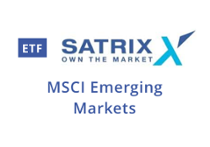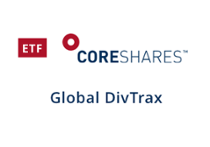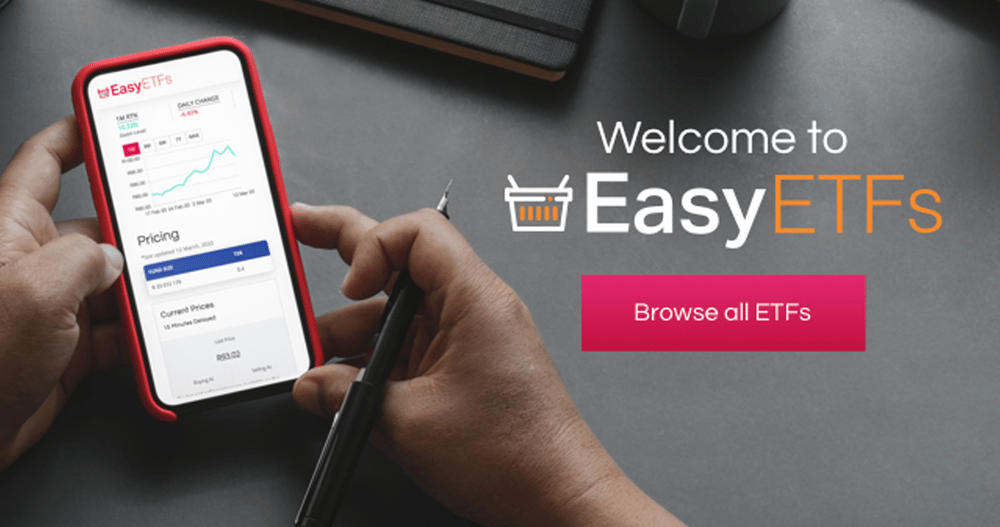Intellidex Reviews June 2020: ETF Picks
Risk assets again outperformed in June, ahead of traditional hedges in times of crisis such as fixed income investments and precious metals. The optimism was driven by the sharp uptick in economic activity as policymakers in most major markets eased restrictions. But investor optimism faded towards the end of the month on fast-rising Covid-19 infections in emerging markets and a resurgence in the US and China.
Emerging market equities remained the most favoured by investors. The MSCI Emerging Markets Index delivered a 7.5% return, leaving it 18.2% up for the second quarter (2020Q2). JSE shares also benefited from the overall surge in global equity markets with the all share index rallying 6.7% and is now up 22% over the past quarter. As is often the case, the improved performance on the JSE seems to have been driven by global rather than local factors.
Gains in developed markets equity indices were in the lower single-digit range. Traditional hedges – fixed income and precious metals – which had rallied at the start of the coronavirus outbreak, were shunned by investors in June.
The Bloomberg Global Barclays Aggregate Bond Index was flat and has gained a measly 2.0% during 2020Q2. Gold and other precious metals were also flat in dollar terms. In the currency market, the rand was wobbly. It strengthened sharply against the dollar in the first week of June but surrendered most of the gains in the latter part of the month.
Against this backdrop, average returns for non-commodity ETFs were positive. A basket of all local non-commodity ETFs rose 5.03% (2020Q2: 15.73%) while the basket of all JSE-listed international ETFs climbed 1.48% (2020Q2: 10.31%). In contrast, the basket of commodity ETFs lost 3.26% (2020Q2:-3.4%), driven by a sharp decline in rhodium prices. Intellidex’s equally weighted ETF portfolio – which is built from these three broad JSE ETF categories – increased 2.91% (2020Q2: 8.3%).
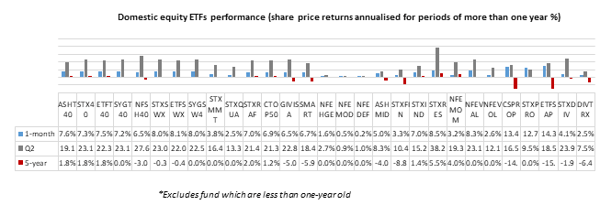
Local ETFs
The local bourse was led by the property sector which scooped the top three positions. The recent easing of lockdown restrictions in SA, which essentially saw most sectors getting back to work, is a massive boost for property funds which had suffered severely due to people staying at home.
Traffic at malls had fallen dramatically and some retailers are refusing or failing to pay their rentals. Some industrial parks had become like ghost towns and landlords were starved of income.
The 1nvest SA Property ETF was the best performer with a mouth-watering return of 14.3% (2020Q2: 18.5%). The CoreShares SA Property Income ETF and Satrix Property ETF occupied second and third positions with gains of 13.4% (2020Q2: 16.5%) and 12.7% (2020Q2: 9.5%) respectively. However, these gains come off a very low base which somewhat exaggerates their returns. All three funds mentioned above are more than 40% down from their valuations at the beginning of the year.
Bonds were the worst performers on the local bourse, led by NewFunds GOVI which declined 2.7% (Q2: 8.6%). The Satrix Inflation-Linked Bond, with a loss of 2.1% for the month, was the second-worst performer. Ashburton Inflation (-1.6%), NewFunds ILBI ETF (-0.4%) and NewFunds Volatility Managed Defensive Equity ETF (0.2%) complete the bottom five.
International ETFs
Internationally, US tech funds dominated, taking three of the top five positions. A granular analysis shows investors gravitated towards cyclical areas of the economy such as energy, hotels, restaurants, airlines and retail. The best performance came from the 1nvest S&P 500 Information Technology Index Feeder ETF, which gained 6.4% and 21.5% for the second quarter.
The Satrix MSCI Emerging Markets ETF took second position with a return of 6% (2020Q2: 14.6%) while Sygnia/Itrix 4th Industrial Revolution, another US fund, was third after gaining 5.8% (2020Q2: 25.1%). Sygnia Itrix EuroStoxx50 and Satrix Nasdaq 100 complete the top five with returns of 1.2% (2020Q2: 14.8%) and 5.3% (Q2: 22.6%) respectively.
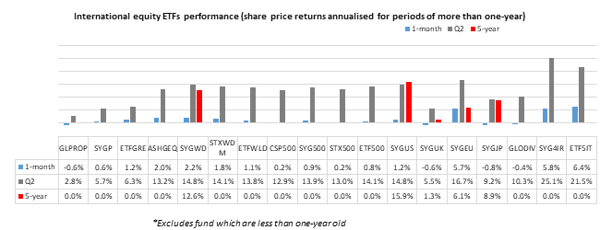
Now for their pick of ETFs
Domestic:
SA’s financial markets are still on a shaky ground so an anti-volatility theme, which we initiated a few months ago, is still a sensible approach. The JSE offers a number of such funds but we prefer the NewFunds Volatility Managed Defensive Equity ETF (+0.2% in June and 1% over 2020Q2), which has a mandate of managing fund volatility and drawdowns simultaneously.
Because volatility of equities is not uniform under all market conditions, the objective is to maintain the same amount of volatility within the fund by reducing equity exposure in times of high volatility and increasing the fund’s cash component. Conversely, when volatility is low the fund will increase its equity exposure and reduce its cash holding.
The objective is to maintain a target level of volatility in the fund at 8%. We like the fund’s agility. Unlike most ETFs which have fixed rebalancing/reconstitution periods, this fund applies the target volatility (TV) process daily, so that volatility is always around the 8% level, ensuring the fund’s risk profile is not excessive. If you have higher risk tolerance you can opt for its cousins with higher TV NewFunds Volatility Managed Moderate Equity ETF with a TV of 15%; and the NewFunds Volatility Managed High Growth Equity ETF with a TV of 20%.
Our main concern with this ETF, though, is that it is still small with assets under management of only R49m. Generally, ETFs have to reach a certain threshold to be viable and this fund is still far off that level. Having a small asset base exposes investor to liquidation risk if the fund does not attract more assets. It may also result in a higher TER than larger funds that have the advantage of economies of scale. It is also pricey with a TER of 0.55%.
International (Developed Markets):
We maintain our foreign exposure to the broad-based Satrix MSCI World Equity Feeder ETF. The ETF gained 1.8% in June (2020Q2: 14.8%). A good alternative, though, is the Ashburton Global 1200 Equity ETF (+2%), but it has a higher TER. Other more focused international equity themes include property, dividend and technology funds. These are worth considering for tactical or other investor-specific reasons.
.
International (Developing Markets):
For developing market exposure, we stick with the Satrix MSCI Emerging Markets ETF (+6%). It invests in a wide range of emerging economies including some of the fast-growing economies such as China and India. The Cloud Atlas AMI Big50 (+0.6%),which focuses on African equities, can be used as a satellite fund to the core Satrix MSCI Emerging Markets fund.
.
Dividend & Income-themed:
If you rely on your investment income for day-to-day expenses, you may want to allocate a portion of your portfolio to ETFs that have a
high distribution ratio. We maintain our choice of dividend-focused strategies like the CoreShares S&P Global Dividend Aristocrats (+2.5%) and the CoreShares South Africa Dividend Aristocrats ETF (-0.4%).
A key advantage of the dividend aristocrat strategy applied by these funds is that it selects constituents based on the actual dividend payouts rather than a dividend yield. This is particurlaly important now when financially challenged companies may deceptively exhibit high yields because of low market prices. The strategy also tends to select companies that can endure difficult market and economic environments and whose earnings are not cyclical.
Such funds are usually overweight in highly cash-generative and resilient sectors. The only gripe we have with these funds is that they are pricey. The CoreShares S&P Global Dividend Aristocrats has a TER of 0.64% and the CoreShares South Africa Dividend Aristocrats ETF costs 0.54% which we find exorbitant.
A good alternative for the local choice is the CoreShares PrefTrax ETF though it is pricier with a TER of 0.63% and its yield is twice as large.
Bonds and Cash:
SA’s fiscus is expected to weaken in the short term as revenue collections take a hit from the lockdown, potential business failures, retrenchments and economic slowdown. Its expenditure, though, is expected to remain sticky. Moody’s also exacerbated the situation by downgrading SA’s credit rating to junk status.
Given this backdrop we maintain our pick for this segment: FirstRand US Dollar Custodian Certificate (-0.9%), which invests in US treasury bonds and offers rand hedge qualities. We steer clear of SA bonds for now.
However, investors with access to broad emerging market bond ETFs should also consider those as a long-term strategy. In the medium term such bonds are likely to come back in style as money that is parked in safe havens starts looking for yields. For short-term investors, usually less than a year, we maintain the, we maintain the NewFunds TRACI (+0.5%) as our choice.
Diversified funds:
If you find the process of diversifying your portfolio daunting, two ETFs can do it for you. They combine equities and bonds to produce a diversified portfolio for two investor archetypes with differing risk appetites: Mapps Protect ETF (+3.2%) is more conservative, usually suitable for older savers. Mapps Growth ETF (+6.1%) suits investors with a longer-term horizon.
Notably, both funds invest in SA-listed assets, thus lack an offshore flavor.
Commodity funds:
Adding a commodity ETF to your portfolio improves diversification because commodities march to the beat of their own drum – they are not in sync with broader markets. We maintain 1nvest Platinum ETF as our pick for this segment. In the short term, the platinum market is expected to remain tight.
Demand will be dented by the temporary closure of automotive factories across the world and ongoing erosion of platinum jewellery consumption. However, medium- to long-term prospects for platinum are enticing. With the palladium price now significantly higher than platinum, automakers are increasingly trying to substitute some of the palladium used in diesel and petrol catalytic convertors with platinum. Should that happen, platinum will regain its allure.
Intellidex Reviews
May 2020: in the news
Background: Exchange-traded funds (ETFs)
Exchange-traded funds (ETFs) are passively managed investment funds that track the performance of a basket of pre-determined assets. They are traded the same way as shares and the main difference is that whereas one share gives exposure to one company, an ETF gives exposure to numerous companies in a single transaction. ETFs can be traded through your broker in the same way as shares, say, on the EasyEquities platform. In addition, they qualify for the tax-free savings account, where both capital and income gains accumulate tax free.
Benefits of ETFs
- Gain instant exposure to various underlying shares or bonds in one transaction
- They diversify risk because a single ETF holds various shares
- They are cost-effective
- They are liquid – it is usually easy to find a buyer or seller and they trade just like shares
- High transparency through daily published index constituents
If you thought this blog was interesting, you should also read:
Disclaimer
This research report was issued by Intellidex (Pty) Ltd. Intellidex aims to deliver impartial and objective assessments of securities, companies or other subjects. This document is issued for information purposes only and is not an offer to purchase or sell investments or related financial instruments. Individuals should undertake their own analysis and/or seek professional advice based on their specific needs before purchasing or selling investments. The information contained in this report is based on sources that Intellidex believes to be reliable, but Intellidex makes no representations or warranties regarding the completeness, accuracy or reliability of any information, facts, estimates, forecasts or opinions contained in this document. The information, opinions, estimates, assumptions, target prices and forecasts could change at any time without prior notice. Intellidex is under no obligation to inform any recipient of this document of any such changes. Intellidex, its directors, officers, staff, agents or associates shall have no liability for any loss or damage of any nature arising from the use of this document.
Remuneration
The opinions or recommendations contained in this report represent the true views of the analyst(s) responsible for preparing the report. The analyst’s remuneration is not affected by the opinions or recommendations contained in this report, although his/her remuneration may be affected by the overall quality of their research, feedback from clients and the financial performance of Intellidex (Pty) Ltd.
Intellidex staff may hold positions in financial instruments or derivatives thereof which are discussed in this document. Trades by staff are subject to Intellidex’s code of conduct which can be obtained by emailing mail@intellidex.coza.
Intellidex may also have, or be seeking to have, a consulting or other professional relationship with the companies mentioned in this report.
Subscribe To Our Research Portal
Search all research
Let Us Help You, Help Yourself
From how-to’s to whos-whos you’ll find a bunch of interesting and helpful stuff in our collection of videos. Our knowledge base is jam packed with answers to all the questions you can think of.


